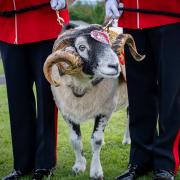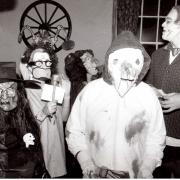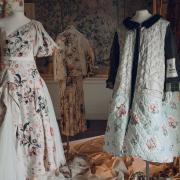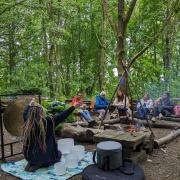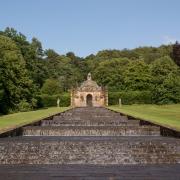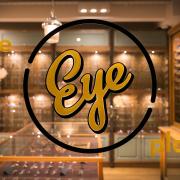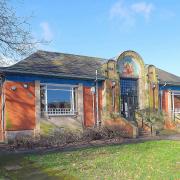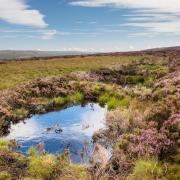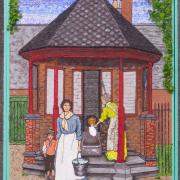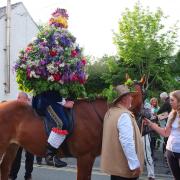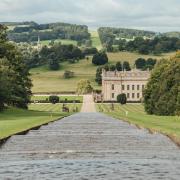Mike Smith heads to Rowsley to chart the story of the stunning Peacock Hotel, a building he describes as ‘one of the most beautiful’ in the Peak District. Here he uncovers tales of intrigue, famous guests, tragedies and wonderful architecture.
Of all the buildings covered in this series of articles about Derbyshire’s ‘Buildings of Delight’, the Peacock Hotel, in the pretty Peak District village of Rowsley, is one of the most delightful.
When writing about Derbyshire in his King’s England series, Arthur Mee waxed lyrically about the hostelry as ‘a joy to see, a study of gables and mullioned windows dating from 1652’.
As Arthur Mee observed, the Peacock is wonderfully eye-catching. As well as twin gables and a stunning array of mullioned and transomed windows, the façade of the hotel has perfect symmetry and features a prominent two-storey projecting porch topped by a sculpture of the proud bird that is the emblem of the Manners family of Haddon Hall.

And because the gritstone used to construct the building is noticeably warmer in shade than normal, the frontage of the hotel has a welcoming glow.
When a 19th century traveller described the Peacock as ‘the beau ideal of a snug English country hostelry’, the building had only been serving as a hotel since 1832.
Originally known as Rowsley Manor, it had been built as a residence for John Stevenson, a steward on the Haddon Hall Estate, whose name is carved in the semi-circular pediment above the front door.

Traditional Derbyshire manor houses
This picturesque building is one of the best examples of a traditional Derbyshire manor house.
Regardless of the date of their construction, many of these manor houses are essentially Jacobean in style.
Even nearby Baslow Hall, constructed as late as 1907, shares lots of architectural features with those of the Peacock, including twin gables, perfect symmetry, an extensive array of transomed windows and a doorway topped by a semi-circular pediment.

Famous guests
Rowsley Manor had served for some years as a dower house for the Haddon Hall Estate before it was converted into a hotel in 1932.
Positioned close to the river Derwent and its confluence with the Wye, a river famed for its population of wild rainbow trout, the hostelry became a favourite place to stay for anglers. They included Baden-Powell, founder of the Scout Movement, who stayed at the Peacock in 1907 during a fishing trip undertaken with his brother.
The hotel has retained its attraction for anglers to this day because of the opportunities it offers for fly-fishing.
Over the years, many other well-known people have been guests at the Peacock.
The painter and sculptor Edwin Landseer, best known for creating the lion sculptures in Trafalgar Square, stayed there with his family in 1868. Another celebrated guest was the pre-Raphaelite artist Edward Burne-Jones, who was so impressed by the hospitality he had received that he gave one of his sketches to the landlady before he left.
Famous actors who have spent time at the Peacock include Douglas Fairbanks, who visited with Mary Pickford in 1924 whilst she was making the silent film Dorothy Vernon of Haddon Hall, and Lillie Langtry, the actress who was the mistress of the Prince of Wales, later King Edward VII.
More recently, Dame Judy Dench was a guest during the shooting of scenes from Jane Eyre at Haddon Hall, as was Keira Knightley when she was filming Pride and Prejudice.

Tragic accidents
In common with many other hotels, the Peacock has served as a venue for inquests.
Genealogist Joanne Penn has unearthed details of two inquests that were held at the hotel following tragic accidents. In 1855, Reverend Samuel Sunderland was killed when a coach returning from a trip to Chatsworth House tipped over at Rowsley Bridge.
A similar tragedy occurred in 1878 when Peter Warren fell from the top of a coach returning from a visit to Haddon Hall and was killed when one of the wheels ran over his neck.
Visits to the two great country houses, thankfully rather less hazardous these days, are still popular with guests at the Peacock, where their accommodation can be selected from 15 individually styled bedrooms.
Extensions made to the building to provide this number of bedrooms have been fashioned in a style compatible with that of the original parts of the manor house.
The interior of the hotel, which is owned by Lord and Lady Edward Manners of Haddon Hall, has been carefully restored to create a blend of contemporary comfort and traditional elegance. The bar area, with its beamed ceiling and open fire, is particularly evocative of times past.
The dining room of the three AA rosettes restaurant contains tables and chairs made by Robert Thompson, known as the ‘Mouseman of Kilburn’ because of his habit of carving a small signature motif of a mouse somewhere on each piece of furniture he manufactured. Hunting for mice is one of the more unexpected delights of a visit to this ‘building of delight’!
Whilst you are there
In addition to being ideally placed for angling trips, taking walks in wonderful countryside and making visits to Haddon Hall and Chatsworth House, the local area has great opportunities for shopping and taking refreshment. It is also a magnet for art lovers.

Peak Shopping Village
Peak Shopping Village was developed on land formerly occupied by marshalling yards and engine sheds. Only the iconic station building, designed by Joseph Paxton, has been left standing.
Outlets include shops selling clothing, bedding, shoes, bags, home furnishings, gifts and books. The ‘village’ also includes an indoor soft play area for children called Peak Adventure.
Eating places

Peak Shopping Village contains two daytime restaurants and coffee shops. The Chatsworth Kitchen serves seasonal food sourced from the Chatsworth Estate. As well as having a selection of cocktails, wines and local ales, it sells quality homeware produced by Derbyshire makers.
Massarella’s serves hearty English breakfasts, coffee and cakes, lunches and afternoon teas. Marston’s Grouse and Claret, located just outside the shopping village, can serve 160 people in the indoor dining rooms and a further 60 in the garden area.
Destinations for art lovers
Gallerytop sells contemporary art from far and wide, as well as works by Derbyshire artists. Thanks to the Art Council’s ‘Own Art Scheme’, art can be purchased on a no-deposit, interest-free loan basis spread over ten months.
Derwent-Wye Fine Art Exhibit Gallery sells modern art by well-known British painters and is a source of the much sought-after work of the Sheffield artist Harry Epworth Allen. It also offers an expert framing and restoration service.




